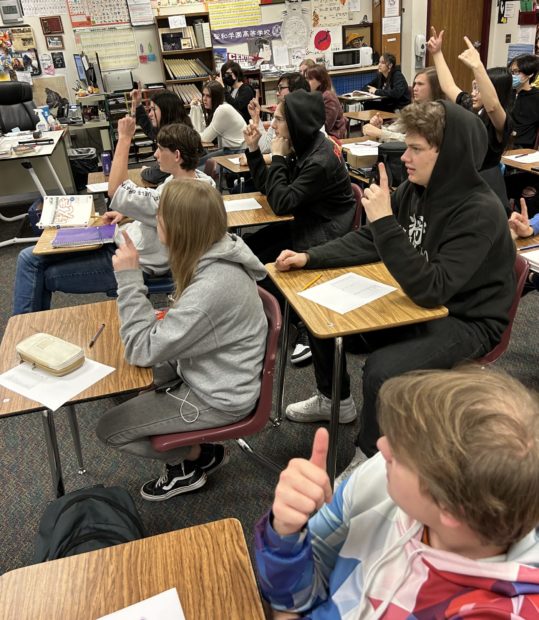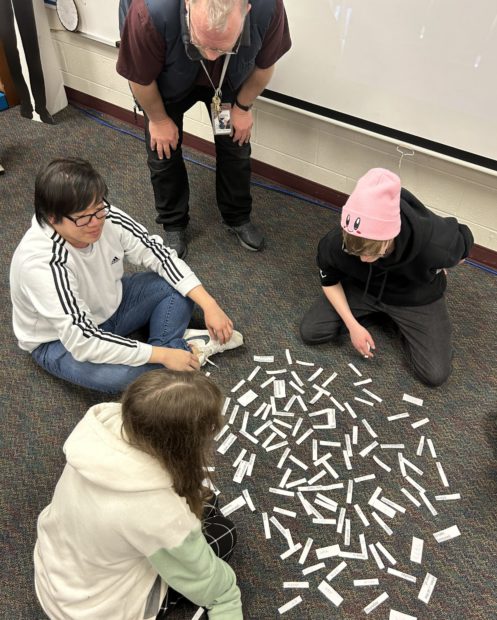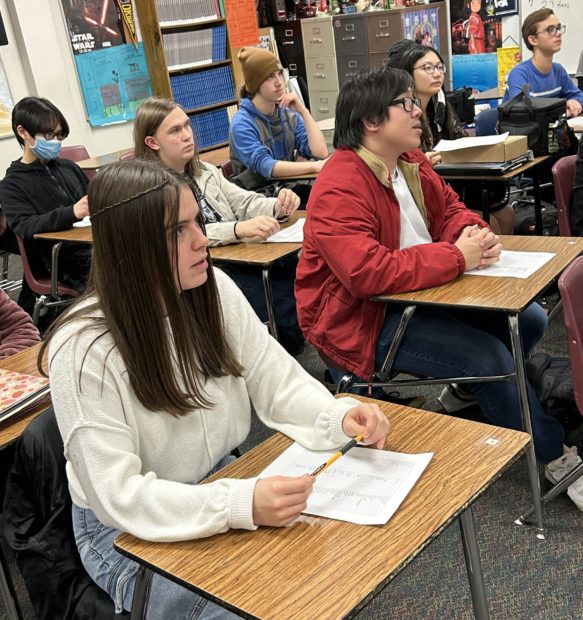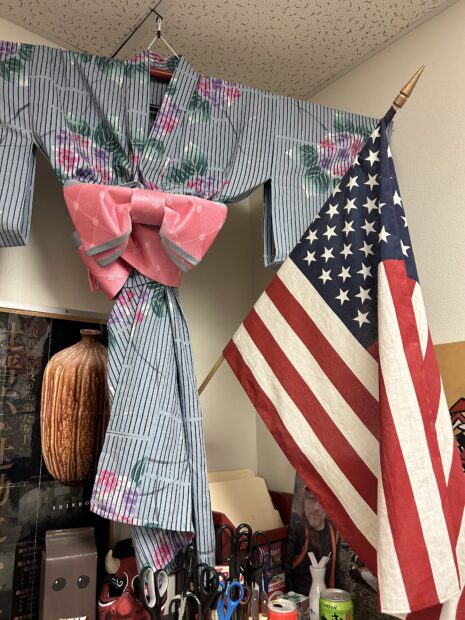Posted on the cluttered bulletin board behind Dale Garrard’s desk are more than 50 photos of smiling faces, colorful graduation announcements, handwritten thank you notes, strange anime drawings, and fading newspaper clippings.
Garrard cherishes them all.
They represent 27 years of memories at Centennial High School introducing students to the ancient language of Japanese. And he’s pretty good at his job.
“He’s gotten people who aren’t interested in Japanese to stay in Japanese class,” said Amy Poulsen, a senior at Centennial High School.

Now in her fourth year of Japanese language class with Garrard, Poulsen earned four Japanese 101 credits from Boise State University while attending his class. The program is state funded so Poulsen — and other classmates who choose to attend — earned those credits tuition free.
“After I took the first year, Mr. Garrard has been like mellow and he’s super helpful. He’ll give you extra lessons … It’s really fun. And I love asking him questions about stuff,” Poulson said.
There are four levels of Japanese language classes, from beginner to advanced. Garrard — who teaches all four levels — instructs about 180 Centennial and 12 Meridian High students through teleconferences.
Garrard’s introduction to Japan started at age 19 while on his LDS mission. Later, he went back to the island nation to teach English multiple times. He passes on that fascination and appreciation. Students are genuinely interested, certainly because the popularity of Japanese culture is growing, but it’s more likely Garrard’s passion.

Soft-spoken with a touch of witty humor, he’s like a classroom conductor: hand gestures, repetition, hands-on activities.
“I always really enjoyed Mr. Garrard as a teacher. He’s a musical guy and I’m a musical guy. So we related that way, and so I just found it really interesting learning about the language itself and also just some other little pieces about Japan as a whole,” said Jeffrey Beller, a third-year language student.
The prestigious award
Success is often measured through proficiency exams or standardized testing. Given the complexity of the language he teaches — Japanese uses four different alphabets — Garrard might suggest otherwise. Japanese writing combines the hiragana, katakana, and kanji alphabets, while romaji is a system where symbols or characters are alphabetized into Roman letters.
Academic success could be measured by winning a national Japanese language award — which is exactly what four of his students did.
A group of third- and fourth-year language students — Beller, Devon Garner, Jonathan Smith, and Dylan Garrard — produced a video that won the “Silver Award” in the video category of George Washington University’s national Japanese language contest “J.LIVE Talk 2022.”
The combination of skilled video production and slapstick humor was a hit. Their video was selected as one of the best by Japanese language professors from four well-known universities.
“I was just really proud of my kids winning,” Garrard said. “Plus, it was kind of prestigious from George Washington University.”
The Sendai language exchange
Garrard also created a class-to-class language exchange spanning five thousand miles and two very different cultures. High school students from Sendai, Japan, viewed Centennial’s video and shared their own reaction video with Garrard’s class.
“What I thought was a bigger deal was the interaction … with the kids in Japan because I think that’s such a good education (practice),” Garrard said. “That’s why I’m in teaching to begin with, to make stuff like that happen.”
Beller shares Garrard’s view. “The communication with the Japanese kids was a really cool experience,” he said.

A different culture
While many students get interested in Japanese through anime or manga (animation or comic books), Garrard joked that some probably sign up because “the teacher is insane, so we’ll take that one.”
They soon discover, however, the course is challenging, but many stick with it because they find the culture so different, and it helps them gain a different perspective, Garrard said.
“So I started because I was just interested in learning a language that was a little different, because most of the other languages Centennial carries are Latin-based languages with the characters we’re used to. So I chose Japanese because it’s a little different,” said Kylie Trull, who is in her fourth year with Garrard.
The school trip to Japan
In June, Garrard will take 30 students from Eagle, Meridian and Centennial high schools to Japan on a week-long study tour.
With a miniature torii gate replica in-hand, Garrard reminded his class that survival skills are important during the upcoming trip. “If you’re lost, you need to be able to tell me which type of shrine you’re at, Shinto or Buddhist.” The two religions are Japan’s largest, and visiting shrines is a way of life for the Japanese and also a major tourist attraction.
“I think one main thing is there’s a big difference between … Japanese schools and American schools. And there’s also a difference between Japanese society and American society. So I’m just really interested to see what some of those things will be,” said Beller, who will accompany the group in June.

Pondering his 27-year teaching career and looking forward to more years introducing young people to a language and culture that’s part of his identity, Garrard used one of his favorite Japanese affirmations: “Gambari Mashou!” — which means keep trying and persevering.
